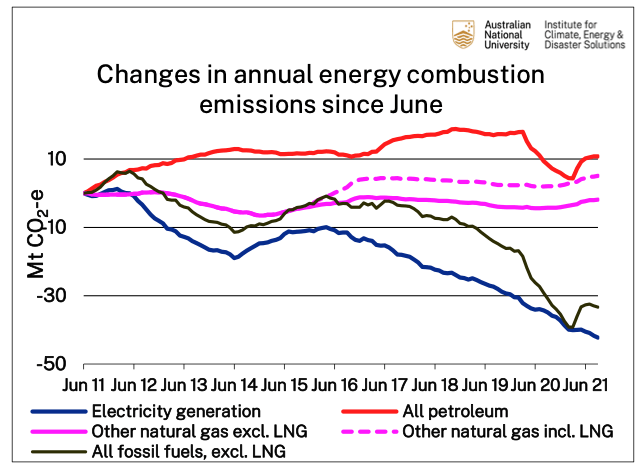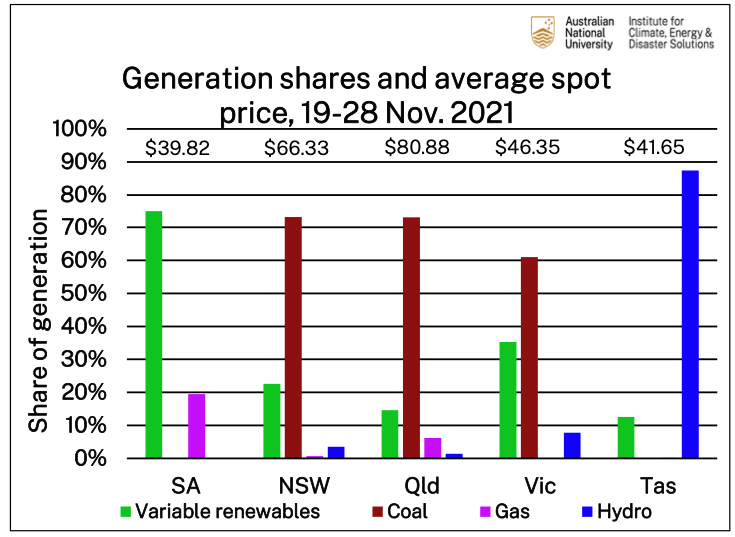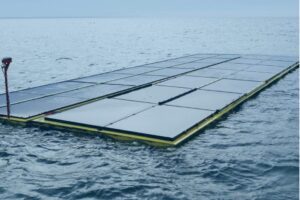New analysis confirms the transformation of Australia’s electricity system towards wind and solar is well underway, and was largely uninterrupted by the Covid-19 pandemic. But it also shows that gas and oil remain well entrenched in Australia’s energy system
The findings have been detailed in the first edition of the Australian Energy Emissions Monitor, the latest in the long-running series of analyses prepared by Dr Hugh Saddler now being published by the ANU’s Institute for Climate, Energy and Disaster Solutions.
Saddler found that Australia’s transition to green electricity sources powered ahead throughout the Covid-19 pandemic and reduced coal use – but little systemic change has been achieved in getting Australia off gas and oil.
“As Australia emerges from the disruptions of lockdowns, the transition of the National Electricity Market towards a low emission future continues,” the report says.
“Conversely, there remains no evidence of any significant transition in either the petroleum or gas systems, with emissions on trend to return to pre-pandemic levels, if not higher.”
“Overall, the contrasts between trends in electricity, petroleum and gas show that, while the electricity system is definitely in the midst of transition, the petroleum and gas systems, just as definitely, show no signs of even starting on transition.”
“It is therefore wrong, and misleading, to refer to an energy transition in Australia, when what is meant is an electricity system transition only.”
It suggests the Morrison government’s ‘gas fired recovery’ may be having its intended effect, propping up Australia’s fossil gas consumption, with the government having poured funds into boosting local supplies.
The analysis found that travel restrictions dented the consumption of liquid fuels, particularly aviation fuel and petrol, but periods of relaxed restrictions suggest that these reductions are likely to prove temporary with little evidence that there have been any notable long-term changes in behaviour or transport technologies.
A lack of support for electric vehicle uptake at a federal level has also contributed to slower Australian uptake of EVs, helping liquid fuel use rebound as restrictions lift.

But in a positive development, the ANU analysis found that Australia’s electricity emissions continued to fall, driven by increased uptake of wind and solar.
The report finds that for the year to November 2021, wind and solar combined to supply a quarter of the electricity in Australia’s main grid with the total amount of renewables – when hydroelectricity is added – netting a 32 per cent market share for the period.
October and November proved to be particularly strong months for renewable generation. Several records were broken as ideal wind conditions, the approaching summer, and milder temperatures sent the market share of wind and solar surging.
“Wind and solar generation always make their largest contribution, as a share of total NEM generation, during the spring months of September, October and November,” the report says.
“On the supply side, September is almost always one of the windiest months of the year, while in October and November, as average wind speed falls away, lengthening days and higher irradiation angles result in rapidly increasing daily solar generation.”
“The resultant effects on the electricity supply system were seen most dramatically in South Australia during the second half of November. They could well be a foretaste of what the whole NEM might be like ten years hence, if present trends continue.”
As has been reported by RenewEconomy, late November saw South Australia powered predominantly by wind and solar supplies, including a full three day period where the two renewable energy sources supplied almost the entirety of the state’s electricity needs.
Not only did the late November period see South Australia record the highest rate of wind and solar generation of any Australian state, but it also recorded the lowest average wholesale electricity price during the period. Tasmania, another renewable energy-rich state, followed closely behind in terms of low electricity prices.

Saddler was cautious about declaring renewables as the solution to low electricity prices but said the data challenged some assertions being made by advocates for more gas and coal generation.
“This one set of calculations cannot be said to demonstrate that high shares of solar and wind generation will automatically deliver low wholesale prices to electricity consumers,” the report says.
“However, two other conclusions can be reached with some certainty. Firstly, having a high share of coal fired generation will not necessarily deliver lower prices.”
“Secondly, modern electricity systems do not need high levels of local dispatchable generation, let alone so-called baseload generation, to deliver highly competitive wholesale prices, while also operating with complete security over extended periods,” it adds.
Good, independent journalism takes time and money. But small independent media sites like RenewEconomy have been excluded from the millions of dollars being handed out to big media companies from the social media giants. To enable us to continue to hold governments and big business to account on climate and the renewable energy transition, and to help us highlight the extraordinary developments in technology and projects that are taking place, you can make a voluntary donation here to help ensure we can continue to offer the service free of charge and to as wide an audience as possible. Thank you for your support.










